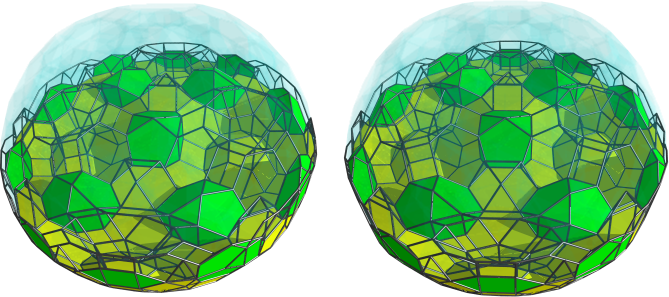D4.6 (EntityTopic, 15)
From Hi.gher. Space
(construction details) |
m (naming) |
||
| Line 4: | Line 4: | ||
| extra={{STS Polytope | | extra={{STS Polytope | ||
}}}} | }}}} | ||
| - | CJ4.6 is a [[CRF polychoron]] [[crown jewel]] discovered by [[student91]] on February 18, 2014. It is a modification of the | + | CJ4.6 is a [[CRF polychoron]] [[crown jewel]] discovered by [[student91]] on February 18, 2014. It is a modification of the [[hydrocantichoron]] o5x3o3x, where 30 icosidodecahedra are replaced by [[bilunabirotunda]]e (J91), with the resulting non-CRF parts substituted by CRF patches containing 12 rosettes of 5 hexagonal prisms alternating with 5 truncated tetrahedra encircling pillars of pentagonal prisms capped by pentagonal rotundae. |
Its construction is as follows: delete the vertices from o5x3o3x of edge length 2, whose first coordinate is less than the Golden Ratio φ or is equal to 2, then push the remaining vertices together (i.e., if the first coordinate is ≥φ then subtract φ; if it's ≤-φ then add φ). The vertices whose original first coordinates were φ become coincident. Then new points x5o3A are added with first coordinates ±1, where A=6φ. These modifications of o5x3o3x cause a reduction of its equatorial cells into 30 bilunabirotunda (J91's) in icosahedral symmetry, with the 12 gaps between them filled by circles of alternating hexagonal prisms and truncated tetrahedra surrounding a pentagonal prism with pentagonal cupolae above and below it. Twelve of the o5x3o's near the equatorial layer are truncated into pentagonal rotundae, and a number of cuboctahedra become triangular cupolae. | Its construction is as follows: delete the vertices from o5x3o3x of edge length 2, whose first coordinate is less than the Golden Ratio φ or is equal to 2, then push the remaining vertices together (i.e., if the first coordinate is ≥φ then subtract φ; if it's ≤-φ then add φ). The vertices whose original first coordinates were φ become coincident. Then new points x5o3A are added with first coordinates ±1, where A=6φ. These modifications of o5x3o3x cause a reduction of its equatorial cells into 30 bilunabirotunda (J91's) in icosahedral symmetry, with the 12 gaps between them filled by circles of alternating hexagonal prisms and truncated tetrahedra surrounding a pentagonal prism with pentagonal cupolae above and below it. Twelve of the o5x3o's near the equatorial layer are truncated into pentagonal rotundae, and a number of cuboctahedra become triangular cupolae. | ||
Revision as of 02:29, 23 February 2014
CJ4.6 is a CRF polychoron crown jewel discovered by student91 on February 18, 2014. It is a modification of the hydrocantichoron o5x3o3x, where 30 icosidodecahedra are replaced by bilunabirotundae (J91), with the resulting non-CRF parts substituted by CRF patches containing 12 rosettes of 5 hexagonal prisms alternating with 5 truncated tetrahedra encircling pillars of pentagonal prisms capped by pentagonal rotundae.
Its construction is as follows: delete the vertices from o5x3o3x of edge length 2, whose first coordinate is less than the Golden Ratio φ or is equal to 2, then push the remaining vertices together (i.e., if the first coordinate is ≥φ then subtract φ; if it's ≤-φ then add φ). The vertices whose original first coordinates were φ become coincident. Then new points x5o3A are added with first coordinates ±1, where A=6φ. These modifications of o5x3o3x cause a reduction of its equatorial cells into 30 bilunabirotunda (J91's) in icosahedral symmetry, with the 12 gaps between them filled by circles of alternating hexagonal prisms and truncated tetrahedra surrounding a pentagonal prism with pentagonal cupolae above and below it. Twelve of the o5x3o's near the equatorial layer are truncated into pentagonal rotundae, and a number of cuboctahedra become triangular cupolae.
Projections
Side-view showing equatorial cells:
Top-view with highlighted equatorial cells:


